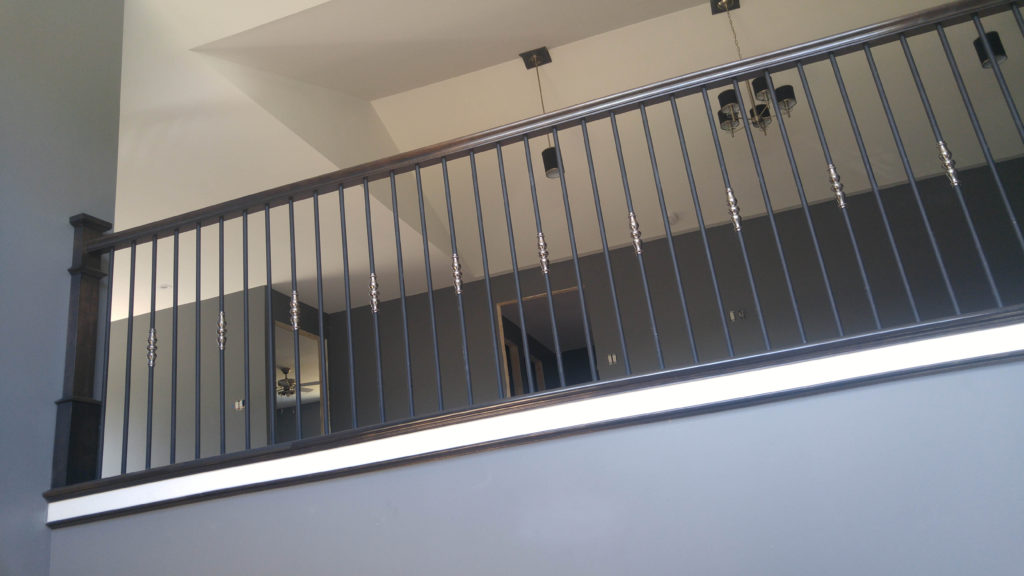Installing Metal Balusters
Our Free Advice
Stay away from metal balusters that only rely on a few small screws to hold them in place at the top and /or bottom ( typically the metal balusters sold at big box stores… stair installers will not warranty them, as the lack structural strength ). See, these metal balusters really have no strength and actually fail new home construction code in some provinces in Canada ( this is why we don’t sell the bracket mount metal balusters ). On a scale of 1 to 5, with 5 being the most difficult… installing new metal balusters rates a 3.
Existing Wood Baluster Removal
Wood balusters may be attached to the handrail and floor in a number of ways. Some balusters are simply toe nailed into place. Others are installed into a hole in the handrail and may have a wood dowel in the base, which goes into the tread or floor. If the bottom portion of the wood baluster does not want to come up, try rotating it counter-clockwise because some balusters are installed into the floor or tread with a double-ended baluster screw. In older homes, wood balusters can actually be dovetailed into the treads. If you encounter a dovetailed baluster, you will either have to cut the wood baluster flush with the tread or remove the mitered end of the tread and knock the baluster out from the side. Most times you simply remove the wood balusters by cutting them in the middle and removing the top and bottom sections of the baluster.

Drilling Installation Holes
If you are installing the metal balusters in the same location as the old wood balusters, you need to check the size and depth of the existing holes. Metal balusters that are 1/2 inch square ( which yours will be ) will require that you drill at least a 5/8″ hole in the floor and a 1/2″ hole in handrails bottom surface. The hole in the handrail will need to be at least 1″ up into the bottom of the handrail. Drill the bottom hole to a depth of approximately 5/8″ to 3/4″. Our powder coated metal balusters have the top of the baluster turned round which will may allow you to use a smaller diameter drill bit for the top hole. The turned top’ tip also allows the baluster to be installed without a metal baluster shoe underneath the handrail. It is a good idea to drill and test fit one metal baluster before drilling all of the holes.
Tip: Changing Baluster Spacing
New code requirements or aesthetics may require you to change the baluster spacing from the original wood baluster layout.
Please note that the 2008 Canadian Residential Code and the 2006 International Residential Code requires that stairways have rails that do not allow the passage of a sphere 4 inches in diameter or greater between the balusters.
Scotia Stairs Ltd. recommends that everyone, seasoned professionals and DIY’ers, should consult your local and provincial building code requirements before starting any project, in order to determine what is necessary in your situation.
If you must install metal balusters in a different location from the original wood balusters, it may be necessary to plug any existing holes in the handrail, floor and/or treads. It is possible in some situations to plug the holes with wood tapered face plugs and then sand them flush with the existing surface. Plugging the existing holes may require that you refinish the wood surfaces.
Level Run Handrail Note
For a residential railing cut each metal baluster down from the bottom square end to a length of approx. 37-1/2” for your level run hand rail ( this is for handrails that are non staircase rails ). For commercial code cut to 42” and set rail height a bit over 43” just to be safe, once again we always recommend you consult your local building inspector in your city.
Open Treads Handrail Note
For a residential railing cut metal balusters down from the bottom square end to a length of approx. 37-1/2” for all front tread balusters and approx. 41-1/2” for all back tread balusters ( this is for staircase rails for residential code ) ( for commercial code check with your local building inspector ).
Railing Height Note
The above are guidelines for Residential applications only and are based on the Canadian Building Code, which states that a height of 36 inches is to be the minimum height of the top of the handrail for a of residential railing. We recommend you contact your local building inspector to confirm the above in your area.
Cutting The Metal Balusters
Measure the distance between the bottom of the handrail and the floor/tread surface. Cut the balusters 1-3/8″ to 1-1/2″ longer than the measured distance. Most balusters have the ornamentation closer to the top of the baluster. This should allow for all of the cutting to be done on the bottom of the baluster and thereby preserve the round tip on the top of the baluster. You can use several different methods for cutting the metal balusters. A metal chop saw with an abrasive blade or a metal cutting band saw can be used. These are available for rent from many local rental centers and the metal chop saws are readily available for purchase from home building hardware centers. A jig-saw or a grinder with a metal cutting blade can also be used. You should measure each location where a baluster should go and cut the specific baluster to size for that location.
Test Fitting One Baluster
Slide a cut baluster up into the hole in the handrail until you can bring the bottom of the baluster in-line with the hole in the floor/tread. Seat the baluster into the hole and determine that there is adequate baluster length still extended into the bottom of the handrail. Adjust the diameter and depth of holes if necessary.
Install Metal Balusters
Slide the metal shoes on the baluster and tape the shoe up so that it is not in the way during installation. Please note that the standard shoes and pitch shoes do not add stability to the metal baluster installation – the shoes are for cosmetic purposes and cover the gaps between the square baluster and the round holes. Apply epoxy or polyurethane adhesive into the top and bottom holes and insert baluster. If you are using standard or pitch shoes, place a small amount of epoxy or adhesive around the bottom of the baluster and lower the shoe in place. Square the baluster and shoe to the handrail and leave undisturbed until the epoxy or adhesive has fully cured.
What Glue To Use
For a fast set up time, we recommend using 2 Part Epoxy Glue or for a 24 hour set up time, we recommend using PL Premium Sub Floor Adhesive to install the metal balusters. The epoxy is 100% solid and does not shrink upon curing. The epoxy cartridges come with a special tip that contains baffles that mix both parts of epoxy as it is dispensing which allows the user to place the “mixed” epoxy directly into the holes without any mess. The PL Premium is the best wood to metal glue on the market, it comes in a caulking tube, so it is easy to dispense. Both are very good products ( PL Premium can be found at any hardware store… it is in a black and gold caulking tube ).








